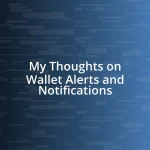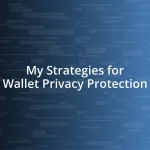Key takeaways:
- Wallet alerts enhance financial awareness by providing real-time notifications, helping to prevent fraud and encourage better spending habits.
- Customization of notification preferences allows individuals to tailor alerts to their financial goals, making them more effective in managing spending and savings.
- Regularly reviewing and adjusting wallet alerts can transform them from overwhelming notifications into valuable tools for financial management and motivation.

Understanding Wallet Alerts
Wallet alerts are like your personal financial watchdog, keeping you informed about your spending habits and balances in real-time. I remember the first time I received a notification about a large transaction that I didn’t make – my heart raced as I quickly checked my account. It instantly reminded me how these alerts can act as both a safety net and a prompt for financial awareness.
For me, the most valuable aspect of wallet alerts is their ability to help prevent fraud. Have you ever had that sinking feeling when you realize your money might be at risk? Knowing that my wallet app is constantly monitoring transactions provides me with peace of mind. It’s like having a trusted friend watching my back every time I use my card.
Moreover, wallet alerts can encourage better spending habits. I recall a period in my life when I set a limit on certain categories, like dining out. Each alert helped me stay accountable and ultimately shifted my choices for the better. Isn’t it fascinating how a simple notification can lead to deeper reflections on our financial behaviors?

Benefits of Wallet Notifications
Having wallet notifications means you’re never out of the loop when it comes to your finances. I once had a moment when I received a real-time alert about an unusually high withdrawal just moments after I’d made a regular purchase. The immediate notification allowed me to act fast, freezing my account and ensuring my funds stayed safe. This responsiveness is one of the greatest benefits of wallet alerts; it’s like having a safety net that catches you before you fall.
Here are some key benefits of wallet notifications:
- Fraud Detection: Instant alerts help you catch unauthorized transactions.
- Budget Management: Notifications can remind you of your spending limits in various categories.
- Financial Awareness: Regular updates increase your understanding of daily expenditures.
- Spending Trends: Alerts can highlight patterns in your spending habits, prompting informed decisions.
- Goal Achievement: With reminders about spending behaviors, it’s easier to stick to savings goals.
It’s remarkable how these alerts create not just a layer of security, but also a framework for more intentional financial choices. They provoke thought about what we value and how we want to manage our finances long-term. For me, every notification has become an opportunity for reflection and adjustment, making an impact I hadn’t anticipated when I first set them up.

Types of Wallet Alerts Available
Wallet alerts come in various forms, each serving a unique purpose in keeping our financial lives organized and secure. For instance, I’ve encountered transaction alerts that notify me instantly when a charge is made. I remember a time when I received one right after I bought a coffee. It was comforting to know that I was being kept informed, and it gave me a sense of control over my finances.
Another type of alert is the low-balance notification. I find this one particularly helpful; it gently nudges me to be mindful of my spending when my account dips below a certain threshold. There was a moment when I almost overspent during a sale, and the alert reminded me just in time. Those few words popping up on my screen felt like a friendly reminder rather than a reprimand, helping me make better choices.
Lastly, some wallets offer spending category alerts, which help track where your money goes. I have settings that notify me when I hit a specific amount in categories like groceries or entertainment. This feature is an eye-opener! It has prompted me to reconsider my dining habits on more than one occasion. Have you ever realized you were spending more than you thought? I certainly have, and these alerts have helped me realign my priorities and decisions.
| Type of Wallet Alert | Description |
|---|---|
| Transaction Alerts | Notify you of every transaction made, providing real-time updates. |
| Low-Balance Notifications | Alert you when your account balance falls below a set limit. |
| Spending Category Alerts | Track and notify spending in specific categories like food or entertainment. |

Setting Up Wallet Alerts
Setting up wallet alerts might sound intimidating at first, but it’s surprisingly straightforward. I remember feeling a bit overwhelmed when I started, but once I navigated through the app’s settings, it transformed into an empowering experience. You simply choose which types of alerts you want, adjust the thresholds, and voilà—you’re on your way to taking control of your finances.
One thing that stood out to me during the setup process was how customizable these alerts can be. For instance, I selected notifications not only for transactions but also for specific spending categories. It’s fascinating how setting these parameters can open your eyes to spending habits you weren’t even aware of. Have you ever thought about why certain spending patterns emerge? Trust me, having those alerts in place helped me understand where my money was going, and that revelation was a game-changer.
Don’t forget to regularly review your alert settings as your needs change. I adjust my alerts every few months to better fit my financial goals. For example, when I started saving for a trip, I tightened my spending category limits to reinforce my new habits. It’s like actively participating in your financial journey rather than just watching it unfold—pretty empowering, right?

Customizing Notification Preferences
Customizing your notification preferences can significantly enhance your wallet experience. I’ll never forget the rush of setting mine up. Initially, I was swamped with so many options, but once I zeroed in on what mattered to me, everything clicked into place. I opted for transaction alerts and got rid of excessive notifications that felt overwhelming. It felt liberating to tailor my experience to what truly helped me stay on top of my finances.
I often wonder how many people are missing out on the benefits of customized settings. For example, I once had my low-balance threshold set too high, and it led to a couple of uncomfortable surprises when I checked my account. By adjusting it to a lower amount, I gained a stronger awareness of my spending patterns, preventing that dreaded overdraft moment. Has that ever happened to you? Finding the right balance made me feel more in control, turning those alerts into valuable financial companions.
Another layer to consider is how different preferences can reflect your current life stage or financial goals. I remember when I was aggressively saving for a down payment on my home; I tweaked my alerts to be even more strict on discretionary spending. It’s fascinating how such small adjustments can lead to awareness shifts—like a little financial coach cheering you on. Have you tried this before? Those tweaks paved the way for me, and I believe they could do the same for anyone looking to refine their financial journey.

Best Practices for Alert Management
Effective alert management is truly a balancing act. When I first started receiving wallet notifications, I found myself on high alert for every transaction, which quickly became overwhelming. I realized the importance of prioritizing alerts that had a direct impact on my financial well-being. By focusing on notifications related to significant spending and unusual transactions, I was able to reduce the noise and make my experience much more manageable. Isn’t it fascinating how honing in on just a few key alerts can reduce stress while enhancing your money management?
Another best practice that reshaped my approach was integrating alerts with my financial routine. I like to check my account every Sunday, so I adjusted my notifications to match this schedule. This way, I get a weekly summary of my financial activity, which keeps me informed without overwhelming me throughout the week. Have you ever considered syncing your alerts with your existing financial habits? It’s a simple tweak, but it helps create a rhythmic flow in managing my finances; like a gentle reminder rather than a frantic alarm.
Lastly, I’ve learned that it’s crucial to stay flexible with my alert preferences. Life changes, and my financial priorities have shifted—from saving for a vacation to planning for retirement. Each time I find myself at a new financial crossroad, I revisit my alert settings. This flexibility has allowed me to stay proactive rather than reactive. Have you ever felt stuck in old habits? Adapting my alerts to reflect my current goals keeps me engaged on my financial journey, turning my wallet into a true partner rather than just a tool.

Reviewing and Adjusting Wallet Alerts
Reviewing your wallet alerts can feel like a mini financial audit, one that truly opens your eyes to your spending habits. I recall a time when I was shocked to find that my alerts were set to notify me of everything—from 50-cent coffee purchases to monthly subscriptions. It became exhausting and, frankly, desensitizing. After reevaluating, I focused on more meaningful notifications, such as alerts for larger transactions and spending near my budget limits. Has it ever felt like your notifications were more of a hassle than a help?
As I took the time to adjust my alerts, I noticed a significant difference. For instance, I realized that I could set up alerts not just for spending, but for savings goals as well. When I started getting reminders about reaching specific milestones, it reignited my motivation. I still remember the thrill of receiving an alert that I hit my savings target for a weekend trip! It made me wonder, how many others are missing out on that exciting moment? Tailoring alerts in this way turned my wallet into a positive reinforcement tool.
Another part of adjustment that resonates with me is the timing of the alerts. I once found myself getting notifications during times when I was already stressed, like at work or during family gatherings. I decided to change my notification schedule to avoid distractions and to have them come through when I could properly engage with my finances. This small tweak drastically reduced any anxiety those alerts had caused. Have you ever felt the need to refocus when managing your finances? It’s about ensuring that your alerts add value, rather than being just more noise in a busy day.













